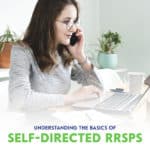Self-Directed RRSPs: Understanding the Basics

If you’re new to RRSP investing, the first thing to understand is that an RRSP is not an actual investment. Rather, it’s a government-sponsored tax shelter designed to encourage Canadians to save for their retirement. I like to visualize RRSPs as an umbrella of sorts, protecting you from taxation rather than wet weather. Underneath the umbrella, you’re free to invest your money in any number of ways – in GICs, mutual funds, ETFs, stocks etc. without being taxed on the income that’s earned. That is until you decide to withdraw your money from your RRSP, presumably after you retire.
What Is a Self-Directed RRSP?
Most RRSP plans are aligned with a specific investment product. If you want to buy mutual funds from an advisor at your bank, for example, they’ll open a mutual fund RRSP account. If you want to add a GIC to your portfolio, you’ll need a separate account for that.
A self-directed RRSP (SDRSP) account allows you to hold a wide variety of investment types together in the same account, from GICs and bonds to mutual funds, ETFs, individual stocks, even precious metals. Having so many investment options in one place gives the account holder a great deal of control.
Another key characteristic of self-directed RRSP plans is that the investor is fully responsible for what happens in the account; they do the research, make the investment decisions, and place the trades, hence the term, self-directed.
Where Can I Get a Self-Directed RRSP?
The vast majority of self-directed RRSPs are available through discount brokerages, also known as online brokers. Canadians have no shortage of discount brokers to choose from. All of the big banks have their own, and there are several independent firms to choose from. While the services offered tend to be very similar, each one has its strengths and weaknesses. Some discount brokerages are known for having low fees, while others boast superior trading platforms and leading market research tools. For more information on what’s available, feel free to check out this review of the top discount brokerages in Canada for 2020.
Characteristics of a Self-Directed RRSP
- Low cost investing
- Wide range of investment options ie: GICs, mutual funds, ETFs, stocks
- Convenience of investing online, or via telephone
- Mobile app allows you to place trades on-the-go
- Access to cutting-edge market research, analytics
- Account holder responsible for investment decisions
- Available customer support
Understanding SDRSP Fees
While self-directed investing makes it possible to avoid most fees, the costs can still add up if you’re not careful. Here are some of the more common fees to look out for in a self-directed plan:
Account Fees
Many discount brokerages charge an annual fee per registered account unless you maintain a minimum account balance, of say, $15,000. A typical account fee is around $100. Not everyone charges, however. Questrade, one of the largest independent brokers, does not have an annual account fee, nor does it charge any commissions on ETF purchases.
Trading Fees
In addition to account fees, you may be subject to fees when you place trades, depending upon the type of investment you’re buying. While most mutual fund trades are free, many of the big bank brokerages charge as much as $9.95/trade to buy and sell stocks and ETFs. It’s easy to see how trading fees could take a big bite out of your overall returns, especially if you’re an active trader.
Transfer Fees
If you transfer money out of a self-directed RRSP to an account at another institution, you’ll be charged a transfer fee by the relinquishing institution. Transfer fees vary, but they can be as much as $100. Transfer fees are charged on a per-account basis, so if you’re moving out multiple accounts, the costs will add up quickly.
Benefits of a Self-Directed RRSP
There are several advantages to investing in a self-directed RRSP. From lower fees, to convenience and flexibility, here are just a few reasons you may want to consider going the self-directed route.
Low Fee Investing
If you’re careful, you can avoid most fees when investing in a self-directed RRSP. By maintaining a minimum account balance, you’ll avoid the hefty annual account fees. If you can’t meet the account minimums, then consider choosing an online broker that doesn’t charge account fees. If you’re planning to buy stocks, consider saving up and buying in larger volumes to cut on trading fees. Alternatively, you could check out Wealthsimple Trade, a mobile-only broker that offers no-fee stock trades.
Choice
Perhaps the biggest advantage of self-directed investing is having the ability to purchase just about any type of investment. You can get all the diversification you need with a portfolio of low fee ETFs while dabbling in stocks inside the same account. If you’re looking for safety, you can purchase GIC investments from a wide variety of financial institutions.
Convenience & Flexibility
Most discount brokers make it easy to transfer funds over from your primary bank account so that you can begin trading. Invest from the comfort of your living room, with everything you need right in front of you. You’ll have access to real-time stock quotes, as well as expert analysis and market research. If you’re interested in a particular stock or ETF but aren’t quite ready to buy, simply add it to your watchlist, and stay up to date on how it’s performing. Most brokerages allow you to access your account and place trades right from the mobile app on your phone.
Drawbacks of a Self-Directed RRSP
Unless you’re following a very simple, passive investing strategy involving the purchase of index mutual funds or ETFs, you have to be pretty hands-on with a self-directed RRSP. That won’t be for everyone. Alternatively, if you hold a variety of investment types, some GICs, funds, ETFs and stocks, rebalancing to maintain your ideal asset allocation can be tricky. As I mentioned previously, you need to keep track of the amount you’re paying in fees. If you’re constantly buying and selling stock, it can get pretty expensive, and impact your returns.
What Is a Self-Directed Mortgage?
Did you know? You can take out a mortgage to buy or refinance a personal residence, and act as both the lender and the borrower. A self-directed RRSP mortgage is a rather complex arrangement that allows you to use funds in your self-directed RRSP to secure a mortgage. To repay the mortgage, you’ll need to make regular, principal and interest payments directly to your self-directed RRSP.
The interest rate will be higher than you would get with a standard mortgage, with the trade-off coming in the form of a higher than standard return on your RRSP investment because you’re paying the interest to yourself. Self-directed mortgages for commercial and rental properties are not permitted. Because of its complex nature, you should seek the advice of a tax professional before proceeding with a self-directed mortgage.
Who Are Self-Directed RRSPs Best Suited For?
Self-directed RRSPs are definitely not for everyone. If you’re new to investing or lack the confidence required to make your own investment decisions, you may be better off dealing with a bank advisor, or trying out robo investing through a company like Wealthsimple, or Nest Wealth. The same goes for anyone who lacks the time or interest required to do their own research and place trades.
On the other hand, if you have a fair amount of investment knowledge, don’t mind putting in the time, and aren’t intimidated by online trading platforms, you may want to consider self-directed investing for the convenience, low fees, and seemingly endless investment options.

